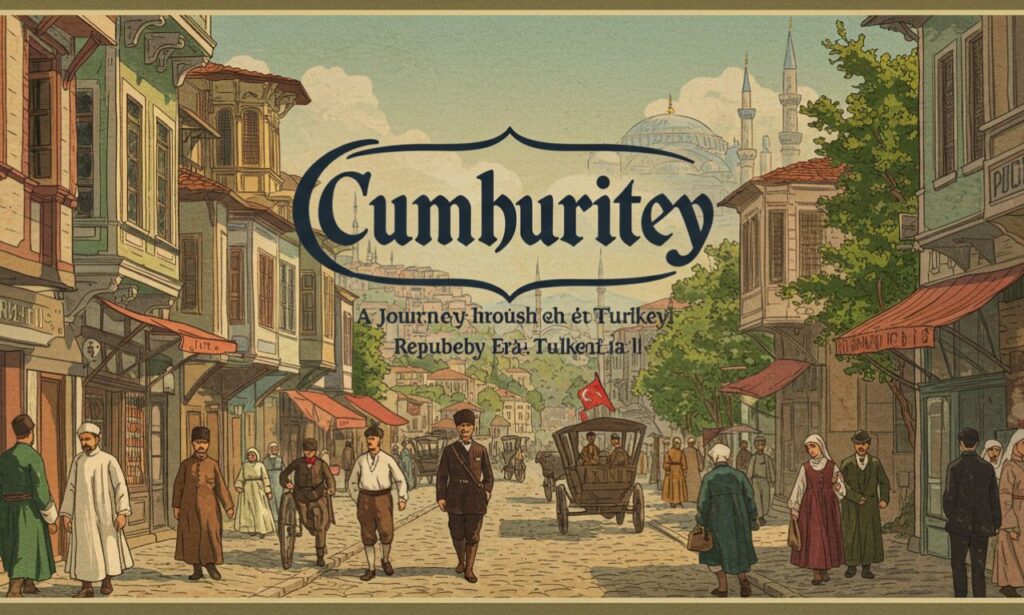Turkey’s journey through the Cumhuritey era is a captivating tale of transformation and resilience. Emerging from the ashes of an empire, this period marks a significant shift in Turkey’s identity, politics, culture, and society. The founding of the Republic in 1923 set forth ambitious goals that aimed to modernize the nation while preserving its rich heritage. It’s a story filled with challenges and triumphs, reflecting both the hopes and struggles of its people.
As we delve into Cumhuritey’s legacy, we explore how it shaped contemporary Turkey—laying down foundations for political reform, economic development, cultural diversity, and social change. Each chapter reveals not just historical facts but also insights into what makes Turkey unique today. Join us on this enlightening journey through time as we uncover the essence of Cumhuritey!
What is Cumhuritey?
Cumhuritey represents the essence of modern Turkey, emerging from a rich history and cultural tapestry. It embodies the principles of democracy, secularism, and nationalism that define the Republic.
The term itself derives from “cumhuriyet,” meaning republic in Turkish. This concept signifies a departure from monarchy to governance by elected representatives.
At its core, Cumhuritey promotes civic engagement and social justice. The ideals fostered during this era encourage citizens to participate actively in shaping their nation’s future.
Furthermore, it emphasizes equality across diverse communities within Turkey’s borders. The journey through Cumhuritey reflects not only political evolution but also an ongoing quest for identity amidst change.
This framework has become a cornerstone for many who advocate progress while honoring tradition. Its influence reaches beyond politics; it resonates in everyday life as citizens navigate their roles within society.
The Founding of the Republic of Turkey
The founding of the Republic of Turkey in 1923 marked a significant transformation for the nation. Spearheaded by Mustafa Kemal Atatürk, this movement arose from the ashes of the Ottoman Empire, which had faced defeat and disintegration following World War I.
Atatürk envisioned a new state grounded in secularism and nationalism. His vision resonated deeply with a population yearning for change after centuries of imperial rule. The declaration on October 29, 1923, was not merely political; it symbolized hope and renewal.
In those early days, Turkish society embarked on an ambitious path to redefine its identity. From language reforms to educational advancements, every facet aimed at modernizing the nation while honoring cultural roots. This period set precedents that would echo through generations as citizens embraced their newfound rights and responsibilities within this republic framework.
Modernization and Reforms under Atatürk
Mustafa Kemal Atatürk, the founder of modern Turkey, embarked on an ambitious journey of modernization. He believed that for Turkey to thrive, a radical transformation was essential. His vision aimed at shedding the remnants of the Ottoman Empire.
Education reform became one of his top priorities. Atatürk established a new education system that emphasized science and secularism over religious teachings. This shift laid the groundwork for a more enlightened society.
Language also underwent significant changes during this era. The introduction of the Latin alphabet replaced Arabic script, making literacy more accessible to all citizens.
Atatürk’s reforms extended into women’s rights as well. He championed gender equality by granting women voting rights earlier than many Western countries did.
These measures were not merely cosmetic; they fundamentally reshaped Turkish identity and set a precedent for progress in various sectors across the nation.
Challenges faced during the Republican Era
The journey of Cumhuritey was not without its hurdles. The early years following the Republic’s establishment were fraught with instability. Internal strife and external threats loomed large.
National unity was a significant challenge. Ethnic tensions simmered beneath the surface, as diverse groups grappled with their identities within a new political framework. There were efforts to enforce cultural homogeneity, which often alienated various communities.
Economic hardships also struck hard during this period. Wars had drained resources, leading to inflation and unemployment. Farmers struggled, while urban populations faced poverty.
Political dissent emerged in response to rapid reforms initiated by Atatürk’s government. Not everyone welcomed modernization; many clung tightly to traditional values and practices.
Amid these struggles, the vision for a secular state ignited resistance from religious factions that felt marginalized in society’s transformation.
Political and Social Changes in Cumhuritey
Political and social changes in Cumhuritey have been profound, altering the landscape of Turkey. The transition from a monarchy to a republic marked a significant shift in governance. Citizens began to embrace democratic ideals, fostering a sense of national identity.
The introduction of multi-party politics encouraged diverse voices. Political pluralism allowed for debate and dissent, paving the way for vibrant civil society movements. Women emerged as pivotal players, gaining the right to vote and participate actively in public life.
Socially, education reforms transformed literacy rates across the nation. Schools became accessible to all segments of society, nurturing an informed populace ready to engage with modernity.
Cultural norms also evolved during this period. Traditional practices coexisted with progressive ideas, creating a rich tapestry that reflects Turkey’s complex identity today. These developments laid the groundwork for ongoing dialogues about freedom and equality within Turkish society.
Economic Growth and Development
Economic growth in Cumhuritey has been a remarkable journey. The early years of the Republic focused on building a strong foundation. Infrastructure projects flourished, connecting cities and rural areas alike.
Agriculture saw significant advancements through modernization. New techniques improved yields, supporting the growing population. This transformation laid the groundwork for urban migration. People flocked to cities seeking better opportunities.
Industrialization gained momentum during this era as well. Factories sprouted across the country, creating jobs and boosting productivity. Turkey began producing goods domestically that were once imported.
Trade relations expanded too, opening doors to international markets. As Turkey established itself on the global stage, foreign investments increased significantly.
This economic evolution was not without its challenges though—balancing tradition with modernity required careful management from leaders and citizens alike. Yet these efforts ushered in an era of prosperity that shaped contemporary Turkish society profoundly.
Cultural Diversity and Preservation in Cumhuritey
Cultural diversity flourishes within Cumhuritey, reflecting Turkey’s rich tapestry of traditions. Various ethnic groups have contributed to the nation’s identity, from Kurds and Laz to Armenians and Greeks. Each community brings its own customs, languages, and culinary delights.
The government has played a vital role in preserving these unique heritages. Initiatives like cultural festivals showcase traditional music, dance, and art forms that might otherwise fade away. These events foster interaction among different cultures.
Education also emphasizes multiculturalism. Schools incorporate lessons on various histories and practices, encouraging respect for all backgrounds.
Artistic expressions thrive too—museums celebrate local craftsmanship while galleries spotlight contemporary artists who blend traditional motifs with modern techniques.
Such efforts ensure that amidst modernization, the essence of diverse identities remains vibrant in Cumhuritey’s social fabric.
Future Outlook for Cumhuritey
The future of Cumhuritey is a tapestry woven with both challenges and opportunities. As Turkey continues to navigate its path in the global arena, the ideals of the Republic will shape its trajectory.
Youth engagement will be crucial. Young Turks are increasingly vocal about their desires for democratic reform and social justice. Their energy can revitalize the republican spirit that Atatürk championed.
Technology also plays a pivotal role. Digital advancements promise new avenues for economic growth and cultural expression, potentially bridging divides within society.
However, issues like political polarization and environmental concerns loom large. Addressing these requires thoughtful dialogue among all citizens.
Cultural preservation efforts will remain vital as well. Celebrating diversity while fostering national identity presents an exciting challenge for future generations committed to upholding the values of Cumhuritey.
The Legacy of the Republican Era in Turkey
The legacy of the Republican Era in Turkey is a tapestry woven from the threads of progress and identity. Founded on principles of secularism, democracy, and nationalism, it reshaped Turkish society.
Education flourished as Atatürk prioritized literacy and modern science. This commitment laid the groundwork for an informed citizenry that values knowledge.
Culturally, a renaissance occurred. Traditional art forms blended with Western influences, creating a unique cultural landscape. The establishment of institutions like museums and theaters reflected this vibrant shift.
Women gained unprecedented rights during this period. Their participation in public life marked significant social transformations that continue to influence gender dynamics today.
Economically, the era set Turkey on a path toward modernization. Infrastructure projects spurred growth while state-led initiatives fostered industrialization.
This rich history remains vital not only to understand contemporary Turkey but also to appreciate its evolving narrative within global contexts.
Conclusion
Cumhuritey represents a significant chapter in Turkey’s history, one that has shaped the nation through its political, social, and cultural evolution. The establishment of the Republic brought about transformative reforms that modernized the country and set it on a path toward progress. Atatürk’s vision fostered an environment where education flourished and women’s rights advanced.
Despite facing numerous challenges—from political unrest to economic fluctuations—Turkey has demonstrated resilience. The journey through Cumhuritey is marked by bold steps toward democracy and inclusivity while respecting the rich tapestry of cultures within its borders.
As we look to the future, the legacy of this era continues to influence contemporary Turkey. It remains vital for citizens to engage with their history as they navigate new challenges ahead. By embracing both tradition and innovation, Cumhuritey stands as a beacon for what lies ahead—a commitment to growth while honoring its past.






